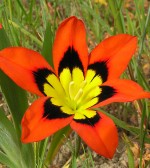 Also called harlequin flower, this tender bulb is endemic to the western cape of South Africa. It is a member of the iris family, Iridaceae, that also includes gladiolus, crocus, and freesia. Fans of lanceolate, pale green leaves emerge from corms from late winter to spring and give rise to short wiry spikes bearing three to six flowers with bright orange tepals and yellow throats rimmed with black. The funnel-shaped flowers are upward facing, 1 ½-2 inches in diameter, and surrounded by pale papery bracts that are streaked with brown. The foliage dies back after flowering. Many cultivars are available in many different colors. Wandflower is a good choice for containers, mixed borders, rock gardens, and wildflower gardens. The flowers are good in the vase. Plants grow best in climates with dry summers and moisture in the winter.
Also called harlequin flower, this tender bulb is endemic to the western cape of South Africa. It is a member of the iris family, Iridaceae, that also includes gladiolus, crocus, and freesia. Fans of lanceolate, pale green leaves emerge from corms from late winter to spring and give rise to short wiry spikes bearing three to six flowers with bright orange tepals and yellow throats rimmed with black. The funnel-shaped flowers are upward facing, 1 ½-2 inches in diameter, and surrounded by pale papery bracts that are streaked with brown. The foliage dies back after flowering. Many cultivars are available in many different colors. Wandflower is a good choice for containers, mixed borders, rock gardens, and wildflower gardens. The flowers are good in the vase. Plants grow best in climates with dry summers and moisture in the winter.
Type: Perennial bulb
Bloom: Bright orange funnel shaped flowers with yellow centers in early spring; cultivars in many other colors
Size: 9-10” H x 12” W
Light: Full sun
Soil: Fertile, medium moist, well-drained
Hardiness: Zones 9-10
Care: Remove dead foliage after blooming; lift and store during the fall in cold climates.
Pests and Diseases: None of significance but watch for slugs and snails.
Propagation: Corm division
Companion plants: Tulips, Siberian iris